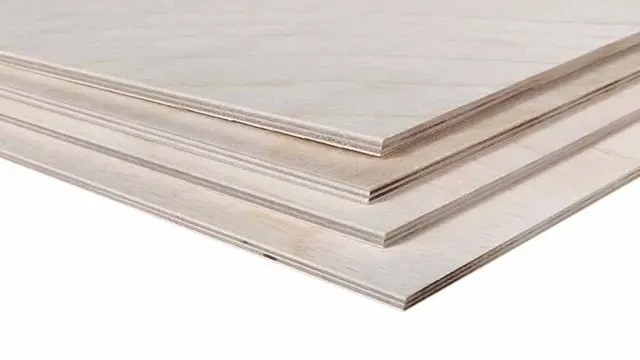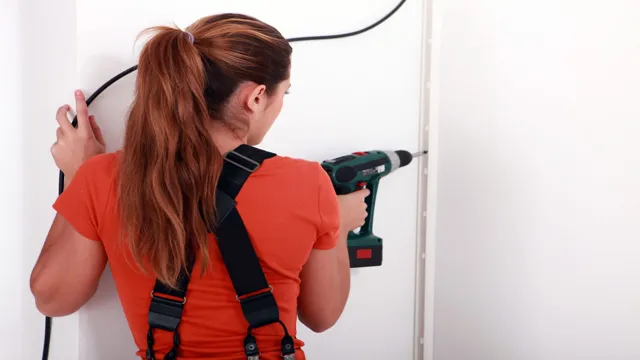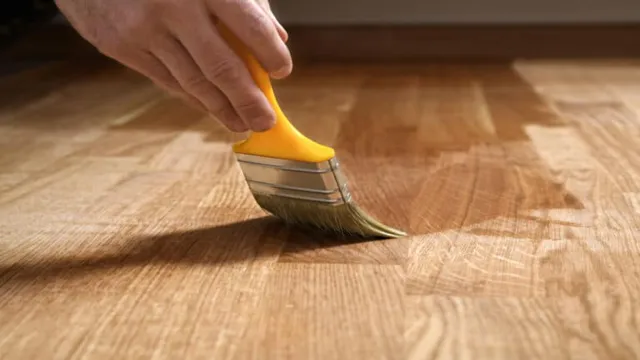What Is the Hardest Plywood for Heavy Duty Projects?

Trying to decide which type of plywood to use for your home renovation project can be overwhelming. With so many options available, it’s easy to become confused about which plywood is the best choice for your needs. If you are looking for a strong and durable material that can handle constant use, then you may be wondering what the hardest plywood is.
While there are many types of plywood that are strong, the hardest plywood is typically made from hardwoods such as oak, birch, or maple. These woods are known for their density and resilience, making them the perfect choice in situations where high durability is a must. The strongest plywood may also be made using marine-grade glue, which makes it resistant to water and rot, making it suitable for outdoor use.
So, what makes hardwoods such as oak so hard? The answer lies in the tree’s growth patterns. Unlike softwood trees that grow quickly and have an open-grained structure, hardwood trees grow slowly, resulting in a denser, tight-knit grain. This makes hardwood lumber more stable and less susceptible to warping, twisting, or splitting.
In conclusion, if you are looking for the hardest plywood available, your best choice will be the one made from hardwoods such as oak, birch, or maple. The density and tight-knit grain of these woods make them the perfect choice for high-wear projects, and the use of high-quality glue makes them resistant to water and other elements. When deciding which plywood to use, keep in mind that the hardest option may also be more expensive than other types.
However, the increased durability and longevity will be worth the investment in the long run.
Understanding Plywood Grades and Hardness
When it comes to plywood, the grading system is an essential aspect you should consider. Plywood is graded based on its appearance, strength, and durability. The grading system ranges from A to D, with A being the highest quality plywood and D being the lowest.
The hardness of plywood is also an important factor to consider when choosing the right one for your project. While there is no definitive answer to what is the hardest plywood, generally, the harder the wood species, the more durable the plywood will be. Hardwood plywood, such as birch plywood, is known for its high strength and durability.
Other harder options include oak, maple, and ash plywood. Ultimately, your choice of the hardest plywood will depend on your project’s requirements and specific needs, so it’s crucial to do your research and consult with experts before making any decisions.
Grades of Plywood
Plywood is a popular building material used in construction projects, furniture making, and various DIY projects. When choosing plywood, it’s essential to understand its grades and hardness, as different grades are designed for different purposes. Plywood grades are categorized based on the quality of the veneers used in the manufacturing process, and they range from A to D.
The A grade is the top-quality plywood, which is sanded and clear of any knots. The B grade has fewer visible defects than C and D, and they are best used for furniture and cabinetry. The C grade has visible knots and can be used for construction and DIY projects, while the D grade is the lowest quality plywood and is suitable for non-structural purposes such as packing material.
The hardness of plywood is determined by the type of wood used in its manufacturing, and it’s measured using the Janka scale. Hardness is essential for determining the durability of the plywood, and some of the hardest woods used in plywoods include oak, maple, cherry, and birch. Understanding the grades and hardness of plywood helps you choose the best quality plywood that meets your specific needs.

Plywood Hardness Scale
Plywood is a versatile building material used in a variety of construction and DIY projects. Understanding plywood grades and hardness is essential to choose the right material for your project. Plywood hardness is measured on a scale known as the Janka hardness test.
This test measures the resistance of the plywood to wear and tear and is measured in pounds-force. The higher the rating on the Janka hardness scale, the harder the plywood. For example, hardwoods like oak and hickory have a higher Janka rating compared to softwoods like pine and spruce.
The grading system for plywood determines its quality, with A being the highest and D being the lowest. A-grade plywood has an even grain, no knots, and no defects, making it suitable for high-end applications like furniture and cabinetry. In contrast, D-grade plywood has knots and other defects and is suitable for use in temporary constructions like sheds and garages.
Understanding the plywood grades and hardness can help you select the right plywood for your project, ensuring a durable and long-lasting finish.
Types of Plywood by Hardness
When it comes to plywood, hardness is often a significant factor to consider. The hardest plywood is usually made from hardwoods such as ash, oak, or maple. Hardwood plywood is often used for structural work or furniture manufacturing, where strength and durability are crucial.
Softwood plywood, on the other hand, is made from softwood trees such as pine or spruce and is generally less hard than hardwood plywood. However, it is still durable and used for a variety of projects such as siding, roofing, and flooring. It’s essential to understand the different types of plywood by hardness to determine the best type for your project.
Soft plywood can be suitable for some projects, while others require the strength and hardness of hardwood plywood. So, when choosing the right plywood for your next project, make sure to consider the hardness of the wood to ensure optimal strength and longevity.
Baltic Birch Plywood
Baltic Birch Plywood When it comes to choosing the right plywood for your woodworking project, hardness is an important factor to consider. The hardness of a plywood sheet determines its durability, strength, and resistance to wear and tear. There are different types of plywood based on their hardness, with some being softer and more flexible for applications that require greater flexibility, and others being harder and more rigid for applications that require greater strength.
One such type of plywood is Baltic Birch plywood, which is known for its exceptional hardness and durability. This type of plywood is made from multiple layers of thin birch veneer that are glued together in alternating directions, forming a thick and sturdy sheet of plywood that is highly resistant to moisture, warping, and twisting. Baltic Birch plywood is ideal for applications where strength and durability are a must, such as cabinets, furniture, and flooring, making it a popular choice among carpenters and woodworkers alike.
So, if you’re looking for a reliable and long-lasting plywood that can withstand even the toughest conditions, Baltic Birch plywood may be just what you need.
Marine Plywood
Marine Plywood Marine plywood is a type of plywood that is specially designed to be used in areas with high moisture. This type of plywood is made with a waterproof glue and is more resistant to rot and decay than regular plywood. It is commonly used in boat building, docks, and other outdoor construction projects.
When it comes to marine plywood, the hardness of the wood is an important factor to consider. There are different types of plywood available based on their hardness, such as A-A, A-B, B-B, and C-C. A-A grade plywood is the strongest and most durable, while C-C is the lowest grade and is not suitable for construction projects that require structural strength.
Depending on your project, it is important to choose the right type of marine plywood to ensure the longevity and durability of your construction.
Phenolic Plywood
Phenolic plywood is a popular building material that is commonly used in the construction industry. It is highly durable, resistant to water and weather conditions, and can withstand high levels of stress. There are several types of plywood based on hardness, with each type having its own unique uses and advantages.
One of the most commonly used types is known as softwood plywood, which is often used in furniture making, construction, and other general-purpose applications. Another type of plywood is hardwood plywood, which is stronger and more durable than softwood plywood, making it ideal for use in heavy-duty applications such as flooring and cabinetry. Marine plywood is another popular type of plywood, known for its waterproof properties and ability to withstand harsh marine environments.
Phenolic plywood is another highly durable and resistant type of plywood that can withstand extreme weather conditions and is often used in industrial settings. Overall, it is essential to choose the right type of plywood based on the specific application to ensure maximum durability and longevity.
Other Factors to Consider
When it comes to selecting the hardest plywood for your project, there are a few other factors to keep in mind beyond just the type of wood used in the construction. One important consideration is the thickness of the plywood. Thicker plywood will generally be stronger and less prone to warping or bending under heavy loads.
Another important factor is the quality of the glue used to bind the layers of wood together. Look for plywood with high-quality, waterproof glue to ensure the strongest bond possible between the layers. Finally, the way in which the plywood is constructed can also impact its strength.
Plywood that is cross-laminated, meaning the wood layers are glued together in alternating directions, will be stronger and more durable than plywood that is simply laminated in one direction. By taking all of these factors into account, you can ensure that you select the hardest plywood possible for your particular project needs.
Thickness and Number of Layers
When it comes to buying a mattress, there are several factors that you need to consider. Apart from the obvious ones such as size and comfort level, you should also take into account the thickness and number of layers. These two factors are important because they affect the support and durability of the mattress.
The thickness or height of the mattress can range from 8 inches to 14 inches, and the number of layers can vary from 2 to Generally, the thicker the mattress, the more comfortable it feels, and the more layers it has, the better the support and distribution of weight. However, thicker mattresses can be more expensive and may not be suitable for people who prefer a firmer sleeping surface.
Similarly, mattresses with more layers may offer better motion isolation and pressure relief, but they may also add to the overall weight and difficulty in moving the mattress around. Therefore, it’s important to find a balance between comfort, support, and your specific needs while taking into consideration the thickness and number of layers when choosing a mattress.
Environmental Factors
When creating a comprehensive plan for your business, there are a lot of environmental factors that should be taken into account, such as climate change, natural disasters, pollution, and other environmental challenges. However, these are just a few of the factors to consider. Other factors that may affect your business include the availability of natural resources, environmental regulations, and the demand for eco-friendly products and services.
While some businesses may be able to thrive in spite of environmental challenges, others may need to pivot or adapt in order to ensure long-term success. It’s important to stay up-to-date on environmental trends and regulations, and to be proactive in finding ways to minimize your business’s impact on the environment. By doing so, you’ll not only be doing your part to protect our planet, but you’ll also be setting your business up for success in the long run.
Conclusion
In conclusion, the answer to what is the hardest plywood boils down to a combination of factors including the type of wood used, the thickness of the layers, and the manufacturing process. However, one thing is for sure, the hardest plywood is not easy to break or dent. It’s tough, durable, and reliable – just like your best friend.
So, if you’re looking for a plywood that can handle any job, look for one that’s strong like bull, tough like a rock, and as steadfast as your most loyal companion. In other words, look for the hardest plywood around.”
FAQs
1. What is plywood made of? A: Plywood is made from thin layers of wood, known as veneers, that are glued together. 2. How many layers does typical plywood have? A: Typical plywood has an odd number of layers, usually three, five, or seven. 3. What makes plywood stronger than solid wood? A: The cross-graining technique used in plywood construction, along with the use of multiple layers, gives it strength and resistance to warping. 4. Can plywood be used in outdoor projects? A: Yes, plywood can be used for outdoor projects if it is properly sealed and treated to protect it from moisture and rot. 5. Is marine plywood the strongest type of plywood? A: Marine plywood is known for its high durability and water resistance, but it may not necessarily be the strongest type of plywood for all applications. 6. Can plywood be stained or painted? A: Yes, plywood can be stained or painted to match the desired finish. 7. What is the hardest type of plywood? A: The hardness of plywood varies depending on the type of wood used and the manufacturing process, but some of the hardest types include Baltic birch plywood, appleply plywood, and hard rock maple plywood.







